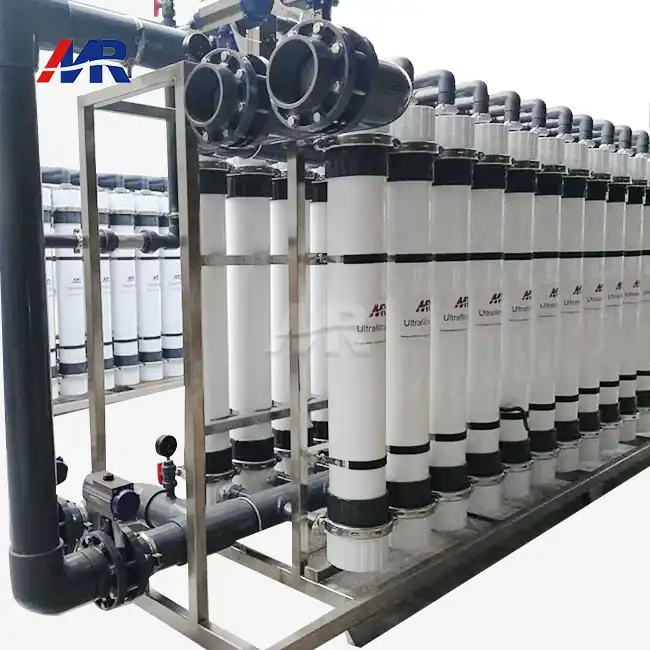How Do Ultrafiltration Systems Remove Contaminants in Industrial Water?
Ultrafiltration systems employ a sophisticated process to eliminate contaminants from industrial water, ensuring the production of high-quality water for various applications. The core of this technology lies in its use of semi-permeable membranes with precisely engineered pore sizes, typically ranging from 0.01 to 0.1 microns. These membranes act as a physical barrier, effectively separating water molecules from larger particles, microorganisms, and dissolved solids.
The Ultrafiltration Process
The ultrafiltration process begins with the pre-treatment of incoming water to remove larger particles and protect the membrane from damage. The pre-treated water is then pumped through the ultrafiltration membrane under pressure. As water passes through the membrane, contaminants larger than the pore size are retained on the feed side, while purified water, known as permeate, flows through to the other side.
This size-exclusion mechanism allows ultrafiltration plants to remove a wide range of contaminants, including:
- Suspended solids and colloids
- Bacteria and protozoa
- Viruses
- Large organic molecules
- Some dissolved solids
The effectiveness of ultrafiltration in removing these contaminants depends on factors such as membrane pore size, operating pressure, and feed water quality. Advanced ultrafiltration systems can achieve filtration accuracies of up to 99.99%, making them highly efficient in producing clean water for industrial use.
Membrane Configuration and Operational Modes
Ultrafiltration membranes are typically configured in hollow fiber or flat sheet formats, with hollow fiber being the most common in industrial applications due to its high packing density and ease of cleaning. These systems can operate in two main modes:
- Dead-end filtration: All feed water passes through the membrane, with periodic backwashing to remove accumulated contaminants.
- Cross-flow filtration: A portion of the feed water flows parallel to the membrane surface, helping to scour and remove accumulated particles.
The choice between these modes depends on the specific application and the nature of the contaminants being removed. Both configurations contribute to the overall efficiency and longevity of the ultrafiltration system.
Ultrafiltration Plant Design: Key Components for High-Efficiency Treatment
Designing an efficient ultrafiltration plant requires careful consideration of various components and their integration into a cohesive system. Each element plays a crucial role in ensuring optimal performance and longevity of the ultrafiltration process. Let's explore the key components that contribute to high-efficiency treatment in ultrafiltration plants.
Pre-treatment Systems
Effective pre-treatment is essential for protecting the ultrafiltration membranes and maximizing their lifespan. Pre-treatment systems typically include:
- Coarse screens: Remove large debris and particles
- Multimedia filters: Reduce turbidity and suspended solids
- Chemical dosing: Adjust pH or add coagulants if necessary
These components work together to prepare the feed water for the ultrafiltration process, reducing the load on the membranes and preventing premature fouling.
Membrane Modules and Racks
The heart of any ultrafiltration plant is its membrane modules. These are typically arranged in racks or skids for easy maintenance and scalability. Key considerations in membrane module design include:
- Membrane material selection (e.g., PVDF, PES)
- Module configuration (hollow fiber or flat sheet)
- Packing density and surface area
- Flow distribution and uniformity
Properly designed membrane racks ensure optimal flow distribution and facilitate efficient cleaning and maintenance procedures.
Pumping and Pressure Control Systems
Ultrafiltration systems require precise control of pressure and flow rates to maintain optimal performance. Key components include:
- Feed pumps: Provide the necessary pressure for water to pass through the membranes
- Pressure sensors and valves: Monitor and control system pressure
- Variable frequency drives (VFDs): Allow for energy-efficient operation by adjusting pump speeds
These components work in tandem to ensure consistent and efficient operation across varying feed water conditions and treatment requirements.
Backwash and Clean-in-Place (CIP) Systems
Regular cleaning is essential for maintaining membrane performance and extending the system's lifespan. Key components of backwash and CIP systems include:
- Backwash pumps and valves
- Chemical storage and dosing equipment
- CIP tanks and heating systems
- Automated control systems for cleaning cycles
These systems ensure that membranes are regularly cleaned to remove accumulated foulants and maintain optimal filtration efficiency.
Monitoring and Control Systems
Advanced monitoring and control systems are crucial for optimizing ultrafiltration plant performance. Key components include:
- Programmable Logic Controllers (PLCs)
- Human-Machine Interfaces (HMIs)
- Online water quality analyzers
- Data logging and reporting systems
These systems allow for real-time monitoring of plant performance, automated operation, and data-driven optimization of the treatment process.
Ultrafiltration vs. Reverse Osmosis: Industrial Water Treatment Applications
While both ultrafiltration and reverse osmosis are membrane-based water treatment technologies, they serve different purposes in industrial applications. Understanding the differences between these two processes is crucial for selecting the most appropriate treatment method for specific water quality requirements.
Filtration Mechanism and Pore Size
Ultrafiltration systems operate on a size-exclusion principle, using membranes with pore sizes ranging from 0.01 to 0.1 microns. This allows them to remove suspended solids, bacteria, viruses, and large organic molecules. Reverse osmosis, on the other hand, uses even tighter membranes with pore sizes as small as 0.0001 microns, capable of removing dissolved salts and smaller organic compounds.
Pressure Requirements and Energy Consumption
Ultrafiltration typically operates at lower pressures (0.1-0.5 MPa) compared to reverse osmosis (2-17 MPa). This difference in operating pressure translates to lower energy consumption for ultrafiltration systems, making them more cost-effective for applications that do not require the removal of dissolved salts.
Water Recovery Rates
Ultrafiltration systems generally have higher water recovery rates (90-95%) compared to reverse osmosis (50-85%). This means that ultrafiltration produces less waste water, making it a more water-efficient option for many industrial applications.
Applications in Industrial Water Treatment
Ultrafiltration is particularly well-suited for:
- Pre-treatment for reverse osmosis systems
- Wastewater reclamation and reuse
- Process water treatment in food and beverage industries
- Cooling tower makeup water treatment
- Surface water treatment for potable use
Reverse osmosis, on the other hand, is typically used for:
- Desalination of seawater or brackish water
- Production of ultrapure water for electronics and pharmaceutical industries
- Boiler feed water treatment in power plants
- Concentration of valuable products in food processing
In many industrial settings, ultrafiltration and reverse osmosis are used in combination, with ultrafiltration serving as a pre-treatment step to protect and extend the life of reverse osmosis membranes.
Choosing Between Ultrafiltration and Reverse Osmosis
The choice between ultrafiltration and reverse osmosis depends on several factors:
- Feed water quality and contaminants present
- Desired product water quality
- Energy costs and availability
- Space constraints
- Environmental regulations and discharge limits
By carefully considering these factors, industrial water treatment professionals can select the most appropriate technology or combination of technologies to meet their specific water quality and operational requirements.
Conclusion
Ultrafiltration systems play a vital role in industrial water treatment, offering a versatile and efficient solution for removing a wide range of contaminants. From their ability to produce high-quality water to their energy-efficient operation, ultrafiltration plants have become indispensable in many industries. As water scarcity and environmental regulations continue to shape industrial practices, the importance of advanced water treatment technologies like ultrafiltration will only grow.
For industries seeking reliable and efficient water treatment solutions, Guangdong Morui Environmental Technology Co., Ltd offers state-of-the-art ultrafiltration systems designed to meet the most demanding water quality requirements. Our 20m³/hour ultrafiltration equipment combines cutting-edge membrane technology with robust design, ensuring high efficiency and reliability across various applications. Whether you're in the food and beverage industry, pharmaceutical manufacturing, or municipal water treatment, our customizable solutions can help you achieve your water quality goals while optimizing operational efficiency.
To learn more about how our ultrafiltration systems can benefit your industry or to discuss your specific water treatment needs, please contact us at benson@guangdongmorui.com. Our team of experts is ready to provide you with comprehensive support, from equipment selection to installation and after-sales service, ensuring a worry-free experience in implementing advanced water treatment solutions for your business.
References
1. Johnson, M. (2022). Advances in Ultrafiltration Technology for Industrial Water Treatment. Water Science and Technology, 85(3), 567-579.
2. Smith, R., & Brown, A. (2021). Comparative Analysis of Membrane Filtration Technologies in Industrial Applications. Journal of Membrane Science, 612, 118461.
3. Lee, S., et al. (2023). Energy Efficiency in Industrial Water Treatment: Ultrafiltration vs. Reverse Osmosis. Desalination, 530, 115696.
4. Zhang, Y., et al. (2022). Ultrafiltration Membrane Fouling Control Strategies for Industrial Wastewater Treatment. Separation and Purification Technology, 290, 120818.
5. Thompson, J., & Davis, R. (2021). Design Optimization of Ultrafiltration Plants for High-Efficiency Industrial Water Treatment. Chemical Engineering Journal, 420, 129706.
6. Garcia-Ivars, J., et al. (2023). Recent Trends in Ultrafiltration Membrane Materials for Industrial Water and Wastewater Treatment. Membranes, 13(2), 207.

_1745823981883.webp)


